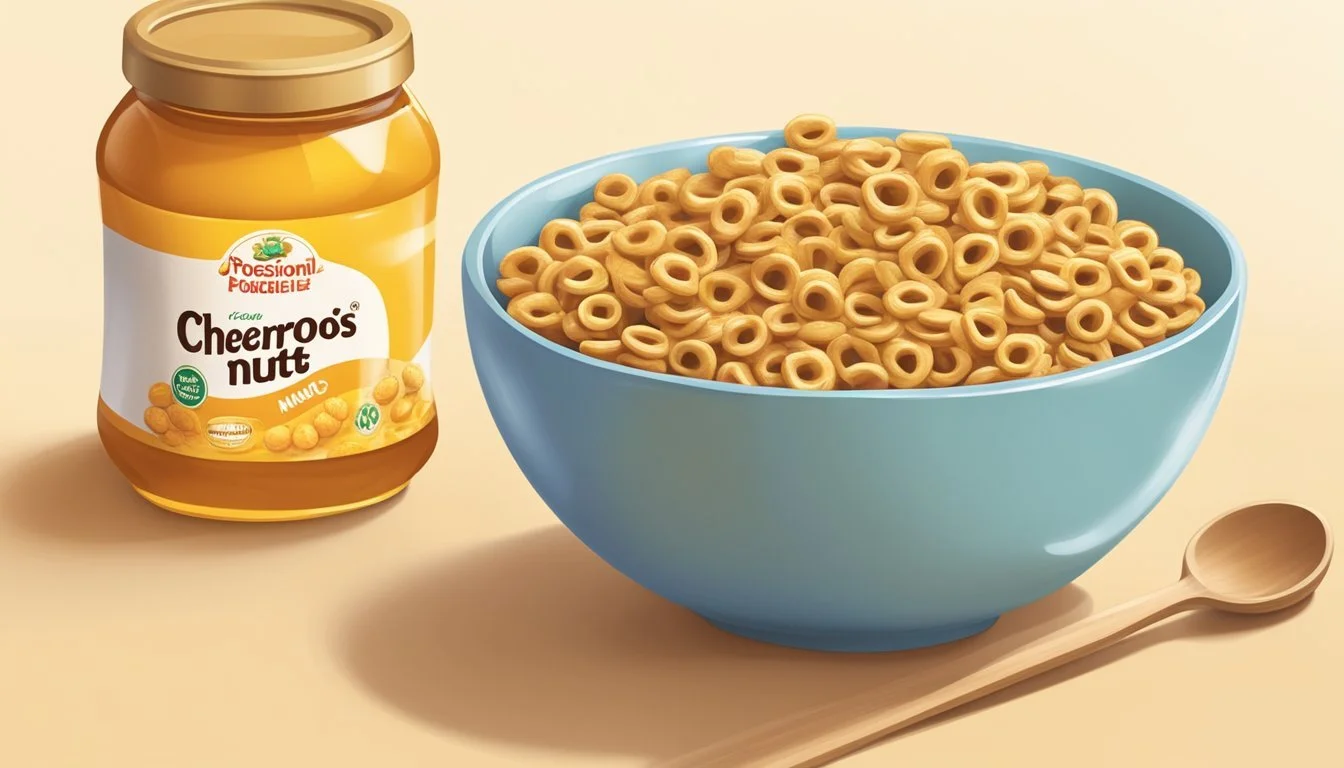Honey Nut Cheerios vs Honey Ohs!
A Nutritional and Taste Comparison
This Article is Part of Our Breakfast Cereal Guide with Details on Honey Nut Cheerios Nutrition and Honey Ohs! Nutrition
When it comes to breakfast cereal, the choice between Honey Nut Cheerios and Honey Ohs can be a tough one. Both cereals offer a distinct flavor and texture profile that appeals to different tastes. Honey Nut Cheerios, with its slightly lower sugar content and higher fiber and protein levels, stands out as the healthier option for those mindful of their nutritional intake.
Honey Nut Cheerios features a complex flavor profile, combining the sweetness of honey with the nuttiness of toasted oats. The cereal pieces are larger and have a more oaty texture compared to Honey Ohs. On the other hand, Honey Ohs is known for its pronounced honey flavor, which can be more overpowering, catering to those who prefer a sweeter start to their day.
For those prioritizing nutrition, Honey Nut Cheerios has the edge due to its reduced sugar content and added protein and fiber. Whether you're attracted to the rich, nutty taste of Honey Nut Cheerios or the intense sweetness of Honey Ohs, understanding these differences can help you make a more informed breakfast choice.
Overview of Honey Nut Cheerios and Honey Ohs!
Honey Nut Cheerios is a popular breakfast cereal produced by General Mills. Known for its distinctive honey and almond flavor, it has been a household favorite for decades. The cereal is crafted from whole grain oats and is often touted for its health benefits, including essential vitamins and minerals.
Honey Ohs, produced by Quaker Oats, offers a unique blend of flavors and textures. With a strong honey taste and a noticeable crunch, it provides a different experience compared to its competitors. This cereal aims to cater to those who enjoy a sweeter and more pronounced honey flavor.
Nutritional Comparison
Nutrient Honey Nut Cheerios Honey Ohs Sugar 10g Higher Fiber 3g Lower Protein 3g Similar
Flavor and Texture
Honey Nut Cheerios: Combines honey with a subtle nutty flavor from toasted oats. The texture is smooth and the cereal pieces are relatively small.
Honey Ohs: Features larger, crunchier pieces with a more intense honey flavor. The texture is more varied, providing a more substantial bite.
Popularity
Honey Nut Cheerios: Widely recognized and loved, often cited as one of the consistently best-selling cereals in the United States.
Honey Ohs: While not as famous as Honey Nut Cheerios, it has a dedicated fan base that appreciates its distinct taste and texture.
Honey Nut Cheerios and Honey Ohs both have unique qualities that appeal to different preferences in the breakfast cereal aisle. Each has carved out its niche and continues to be enjoyed by cereal enthusiasts.
Nutritional Comparison
When evaluating Honey Nut Cheerios and Honey Ohs, several key nutritional metrics such as calories, sugars, fats, vitamins, minerals, fiber, and whole grains need to be scrutinized. Each cereal offers different nutritional benefits, which are fundamental for making an informed decision.
Nutritional Value and Content
Honey Nut Cheerios and Honey Ohs both offer distinct nutritional profiles. Honey Nut Cheerios provides essential nutrients such as whole grain oats, which are a primary ingredient.
Honey Ohs, on the other hand, typically contains a mix of corn, oats, and honey, bringing a different array of nutrients. Both cereals include various vitamins and minerals, though the specific quantities can vary. Consumers should check the current packaging for the most accurate information on ingredients and nutritional content.
Calories, Sugars, and Fats
Honey Nut Cheerios generally has lower calories per serving compared to Honey Ohs. Each serving of Honey Nut Cheerios contains about 110 calories, 9 grams of sugar, and 1.5 grams of fat.
In contrast, Honey Ohs tends to have a higher calorie count, with one serving containing approximately 120 calories, 11 grams of sugar, and 2 grams of fat. Checking the nutritional labels for updated information on these values is recommended.
Vitamins and Minerals
Honey Nut Cheerios is fortified with a variety of vitamins and minerals including iron, vitamin D, and several B vitamins such as niacinamide (vitamin B3), vitamin B6, and vitamin B12.
Honey Ohs also contains essential vitamins and minerals but may vary in the amounts of each. Both cereals typically include calcium, vitamin C, and potassium. Regular consumption of these cereals can contribute to meeting daily nutritional requirements for these vitamins and minerals.
Fiber and Whole Grains
Honey Nut Cheerios is known for being rich in whole grains, primarily oats, which contribute to a higher fiber content. Each serving provides about 3 grams of dietary fiber.
Honey Ohs, while also containing whole grains, offers slightly less fiber, averaging around 2 grams per serving. Whole grain content is crucial for maintaining good digestive health and providing sustained energy throughout the day.
By assessing these nutritional aspects, consumers can make better dietary choices based on their individual health goals and nutritional needs.
Ingredients Profile
Understanding the ingredients of Honey Nut Cheerios and Honey Ohs provides insight into their flavor, nutrition, and health impact. This section breaks down their sweeteners, grains, fibers, preservatives, and additives.
Sweeteners and Flavorings
Honey Nut Cheerios utilize a combination of sweeteners that include brown sugar syrup, corn syrup, and honey. The addition of natural almond flavor adds complexity to its taste. Honey Ohs, on the other hand, tend to be slightly sweeter, primarily due to a higher content of sugar and honey.
Both brands incorporate honey, but Honey Ohs’ flavor is more straightforward, while Honey Nut Cheerios benefit from the additional layers provided by molasses and malt flavor.
Grains and Fiber Sources
Both cereals feature whole grains as their primary ingredient, but the types and amounts differ. Honey Nut Cheerios primarily use whole grain oats, contributing to its dietary fiber content, which stands at around 1.5 grams per serving.
Honey Ohs combine oats, corn flour, and wheat flour, creating a richer texture but varying fiber content. Cheerios is also marketed as gluten-free, making it a preferred choice for those with gluten sensitivities, a distinguishing feature not highlighted in Honey Ohs.
Preservatives and Additives
To extend shelf life, Honey Nut Cheerios incorporate mixed tocopherols (Vitamin E) as a preservative. This natural antioxidant protects oils and fats from becoming rancid. Additionally, corn starch is used to bind ingredients and maintain texture.
Honey Ohs use similar preservatives but may have different formulations, including varying types of tocopherols. Both cereals aim to balance shelf life with maintaining a natural ingredient profile, avoiding overly synthetic additives.
Taste and Texture Analysis
Honey Nut Cheerios and Honey Ohs! offer distinct differences in their flavor profiles and textures. Understanding these characteristics can help consumers decide which cereal best suits their preferences.
Flavor Profiles
Honey Nut Cheerios offer a nutty flavor thanks to the use of toasted oats and almond flavoring. The honey adds a mild sweetness that complements the oat base without overpowering it.
Honey Ohs! have a stronger honey flavor that is more intense. The sweetness is more pronounced and can be considered more sugary compared to Honey Nut Cheerios. There is less complexity in the flavor, making it straightforward and sweet but less nuanced.
Texture and Consistency
Honey Nut Cheerios have a slightly larger cereal piece size, contributing to a more oaty texture. The cereal retains its crunch even when mixed with milk, providing a consistent eating experience.
Honey Ohs! are known for their crunchiness as well, but the texture is less oaty and more sugary. They tend to become softer more quickly when exposed to milk, which could affect the overall eating experience.
By comparing these aspects, consumers can choose the cereal that aligns with their taste and texture preferences.
Health and Diet Considerations
When comparing Honey Nut Cheerios and Honey Ohs for their health impacts, it’s important to evaluate nutrient content and suitability for various dietary needs. Key considerations include protein, fat, sugar, and fortified nutrients.
Healthier Option Evaluation
Protein and Fiber Content: Honey Nut Cheerios contains 3 grams of protein and 3 grams of dietary fiber per serving. In contrast, Honey Ohs offers just 1 gram of protein and lacks significant fiber content, making Honey Nut Cheerios a better option for increasing protein and fiber intake.
Sugar and Fat: Honey Ohs has 2 grams of fat and 10 grams of sugar per serving, whereas Honey Nut Cheerios has 1 gram of fat and slightly less sugar. This reduction in sugar and fat makes Honey Nut Cheerios a better choice for those managing sugar intake and aiming for lower fat consumption.
Calories and Carbohydrates: With 110 calories per serving, Honey Nut Cheerios is relatively low in calories. It also has 22 grams of total carbohydrates, including 11.5 grams of complex carbohydrates, making it a suitable choice for a balanced breakfast. Honey Ohs contributes slightly higher calories and varied carbohydrate content but lacks the same nutritional balance.
Dietary Restrictions and Fortification
Sodium and Fat Types: Honey Nut Cheerios offers a lower sodium option with 160 milligrams per serving, making it favorable for heart health. It also provides a mix of polyunsaturated and monounsaturated fats, important for maintaining balanced fat intake. Honey Ohs, with higher sodium content and less healthy fats, is less optimal for those on restricted-sodium or heart-healthy diets.
Fortified Nutrients: Both cereals are fortified, but Honey Nut Cheerios stands out with added vitamins and minerals such as iron, calcium, and various B vitamins. This fortification supports overall dietary intake and compensates for potential nutritional gaps. The fortification in Honey Ohs is less comprehensive, making Honey Nut Cheerios the more fortified choice.
Dietary Suitability: For those following specific diet plans, such as low-sugar or high-fiber diets, Honey Nut Cheerios provides more favorable options. It caters to a wider array of dietary restrictions by balancing nutrient content and offering essential fortified vitamins. Honey Ohs may not meet the same standards due to its higher sugar and lower fiber content.
Honey Nut Cheerios often emerges as the preferred choice for a heart-healthy and balanced breakfast, offering a more complete nutrient profile suitable for a variety of dietary needs and restrictions.
Market Analysis
Honey Nut Cheerios and Honey Ohs are two popular cereal options, each with distinct sales trends, consumer preferences, and price points. The following analysis covers these aspects to provide a clear understanding for potential consumers.
Sales and Popularity Trends
Honey Nut Cheerios, produced by General Mills, has maintained a strong market presence for decades. This cereal often ranks high in sales, particularly in the adult demographic. According to recent sales data, Honey Nut Cheerios continues to be one of the top-selling cereals in the United States.
Honey Ohs, under the Quaker Oats brand, also enjoys considerable market popularity. While not as dominant as Honey Nut Cheerios, it appeals particularly to families with young kids due to its sweeter taste. Various polls indicate that both cereals enjoy substantial market shares but attract different core audiences.
Consumer Preferences and Reviews
Consumer reviews for Honey Nut Cheerios highlight its balanced sweetness and nutritional benefits. Many reviewers appreciate its complex flavor profile, featuring honey, brown sugar, and oats. This cereal is often favored by adults who seek a healthier breakfast option without compromising on taste.
Honey Ohs tend to receive praise for their crunchiness and sweet, honey-flavored taste. They are particularly popular among kids and those with a sweet tooth. In various cereal ratings, Honey Ohs are noted for their unique texture and flavor, making them a frequent choice for breakfast.
Availability and Price Comparison
Both cereals are widely available in major retail chains like Walmart and Target. The pricing for Honey Nut Cheerios is often slightly higher compared to Honey Ohs, reflecting its premium branding and added nutritional value.
Honey Nut Cheerios are typically priced around $3.99 for a standard 12-ounce box, while Honey Ohs might cost about $3.49 for a similar serving size. Despite the price difference, both cereals remain affordable. Shoppers can often find promotions and discounts, particularly for bulk purchases, making both options budget-friendly.
The ready availability and affordable price points of both cereals add to their appeal, ensuring they remain popular choices for diverse consumer groups seeking taste and value.
More on Honey Nut Cheerios
Cinnamon Toast Crunch vs Honey Nut Cheerios: Which is better?
Honey Nut Cheerios vs Kellogg's Apple Jacks: Which is better?
Honey Nut Cheerios vs Kellogg's Froot Loops: Which is better?
Honey Nut Cheerios vs Post GrapevsNut Flakes: Which is better?
Honey Nut Cheerios vs Post Raisin Bran Cereal: Which is better?





